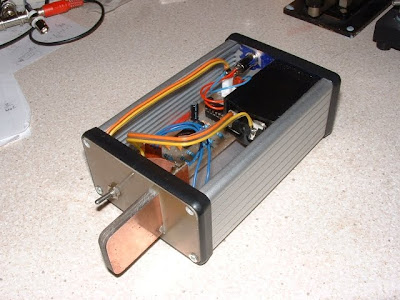Today, making the best of a day off from the usual pattern of Fridays, I took another small step on the path to multi-band operation for the multi-mode beacon (
Blogs passim). I had completed and tested the new
bandpass filter (populated for 30 and 40m operation, with one as yet undedicated channel). Now it was time to install the new element in the box...
As the cold spell continues, work in my unheated workshop remains a non-starter. Accordingly, I had to drill all the new holes in the aluminium enclosure using a hand-held drill in the shack. That was going to be easy enough - but the bigger problem was with the marking out that preceded the actual drilling (
all the measuring / marking kit is in the workshop and measuring, marking and centre-punching whilst balancing an object on your knee is hardly ideal). Fortunately, I had an idea...
Now - I'm sure this is "old hat" - but it had never occurred to me before. I could make full-size templates for all the boards (the new bandpass and the
controller, which needed to be moved to accommodate the new board) in paper, using the
Eagle PCB package with which the boards were designed. I printed them out and pasted them into the desired positions...

Voilà - marking out done "automatically" - drilling the holes was a breeze!
Here's the bandpass board
in situ, beyond the re-located controller...

Notice that I didn't bother to remove the paper templates - they're not doing any harm (in fact, they add a layer of insulation, potentially useful should anything -
like a rogue nut - roll under the board and short to the case).
I also decided to take the opportunity to tidy up the power distribution arrangements - previously I'd just soldered more and more pairs of wires onto the tags of the 2.1mm DC Socket and things were getting awkward. Nothing that a scrap of Veroboard and a few Molex connectors couldn't handle. I even had the foresight to include two spare connectors (which will power the
receiver and the switching output LowPass filter when I get time)...

It is working FB on 30m (
I've arranged things such that the BandPass board "defaults" to 30m on power up). Now, I've got a pretty big/boring programming job to do to get the system running on 30 and 40m - adding to the
menu system, switching the new bandpass filter and controlling the
DDS. Just the sort of job to fill up a few quiet hours when I need time away from the fun, food and drink of the Christmas festivities - or from
"Winter Sports"!
Talking of which, I am listening to
"the message of the angels" from King's as I write. The last verse of the Processional (with
Cleobury's descant) sounded a bit shambolic, I must say! Things can only get better...
...-.- de m0xpd
Well, the service has ended and it certainly did not get better!
It would be interesting to know if the BBC OB crew were the usual (
and usually excellent)
"Choral Evensong" team - poor microphone placement could have explained some of the apparent timing issues. Otherwise, more questions will be asked of Dr Cleobury, who himself asked an awful lot of the trebles to follow him on his uncomfortable harmonic contortions in the "
Adeste Fidelis" descant.
Finally, perhaps it would be kindest quietly to draw a veil over the dubitable liturgical design (not to mention the ordinary, secular nonsense) demonstrated by singing "Born this Happy Morning" at a quarter past four in the afternoon!













